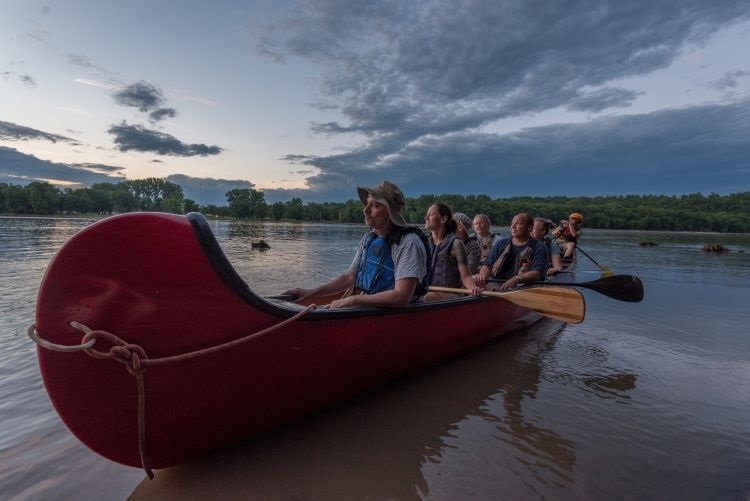Dean Klinkenberg laughs when he talks about his first experience paddling on the Mississippi River, still not sure why he chose to head north — against the current.
He was a college student at the University of Wisconsin-La Crosse when he and a friend “decided it would be a good idea for some reason to paddle upstream to start off.” They traveled a few miles until they found a sandbar, pulled over, had some snacks and went for a swim.
“I loved the whole experience of being out there on the big river, finding an island to just relax. I think that opened my eyes to the possibilities,” said Klinkenberg.
At age 55, Klinkenberg is now a writer who dedicates much of his time to encouraging others to try taking non-motorized boats on the Mississippi.

St. Louis author Dean Klinkenberg, the Mississippi Valley Traveler
“One of the things that convinced me early on that someone needed to do this is that I would hear stories about people who were obsessed with seeing the Mississippi — sometimes travelers from other countries — and they’d rent a car and drive to the [river], and they’d look at it and maybe step in it, and then they’d leave,” he said.
But after writing seven guidebooks to the river and maintaining a blog for a decade, Klinkenberg has in recent years noticed a change.
“There have always been fragments of people who had an interest in the river because of Mark Twain or blues music, but there is a growing interest in the Mississippi as a place to paddle. Every year, we have more people doing the source-to-sea trip [down the whole length of the Mississippi],” he said.
The big rivers have so much diversity of wildlife
Klinkenberg is attracted to paddling on the Mississippi rather than, say, whitewater rafting, because “it’s a little more meditative. It’s little more of a marathon than a sprint. The big rivers have so much diversity of wildlife. The ecology sometimes changes from mile to mile.”
Klinkenberg describes himself as having a “moderate level of paddling experience” on the river. He’s done five or six multi-day trips and “more day trips than I could count,” he said. One of his more memorable experiences happened in 2015, when he and a small group in two large canoes traveled about 100 miles from New Orleans to the Gulf of Mexico.
“I expected it to be heavily industrial and kind of ugly, that the water would be dirty and stinky. But I really wanted to get to the end of the river because you can’t drive there. You can only get there by boat,” said Klinkeberg. “It turned out to be surprisingly beautiful in a lot of places, particularly down around mile zero, where the main channel splits off into several different passes.”
The author also enjoys paddling closer to home (he grew up moving around the Midwest but currently lives in the Shaw neighborhood of St. Louis). His favorite spot: a stretch of the Mississippi from the Chain of Rocks Bridge to the Gateway Arch Grounds where there is no commercial traffic allowed.
“It’s remarkable to me that you have this little bit of river where you don’t find big boats, and you can find islands with bald eagles and beavers and all kinds of wildlife, and you’re really just a few miles from downtown,” he said.
Klinkenberg sits on the board of Mississippi River Water Trail Association, which promotes the river as a paddling destination, and he hopes more people will be interested in becoming “stewards [of the river] and look out for it.” There are ongoing battles about proposed development along the shore that some fear will damage the river ecology.
“I hope more people take another look at the river and understand what it is that we are looking at,” he said. “Some may want to get out there and try to paddle it. Some may just want to go for a hike or bike a ride along it. But we’re really lucky to have that big river next to us, and I think we need to spend more time with it.”
—————————————-
The Write Stuff
Dean Klinkenberg’s guidebooks under the moniker “The Mississippi Valley Traveler” mostly focus on the upper parts of the river, from the headwaters in Lake Itasca, Minnesota, to the Great River Road and confluence with the Illinois River in Grafton, Illinois. He’s also written two mysteries set in the Quad Cities and is currently working on a book that looks at “how much we’ve engineered the river, and what it has cost us to do so.” mississippivalleytraveler.com
Author: Eric Berger is a regular contributor to Terrain Magazine
Image: Lead image courtesy of Andrew Dobson


Leave A Comment